Article
Practice Pointers: This piece of paper can boost your income
A well-designed, up-to-date, and error-free charge ticket improves Medicare compliance, coding, and, ultimately, collections.
A well-designed, up-to-date, and error-free charge ticket improves Medicare compliance, coding, and, ultimately, collections.
An internal medicine group recently turned to consultant Crystal Reeves with the Coker Group in Roswell, GA, for advice on how to improve its coding and boost revenue. Reeves instinctively asked to see the group's charge ticket.
"The form listed some procedures that weren't reimbursable, and therefore were wasting space," says Reeves. "One example was pulse oximetry. Medicare and most private health plans bundle it into an evaluation and management code. By including pulse oximetry on the form, the doctors bumped out a reimbursable service. I compare the space on a charge ticket to ocean-front propertylimited and very valuable."
Whether it's called a charge ticket, a Superbill, an encounter form, or a routing slip, that humble piece of paper kicks off the reimbursement cycle and amounts to a report card on your grasp of coding, billing, and practice management. If it's replete with defunct, nonreimbursable, rare, transposed, or incomplete codes, you could be losing thousands of dollars a year in revenue, and risking a Medicare audit.
We've interviewed Reeves and other experts to help you make the most of paper charge tickets, so you get every dollar you're owed.
The right CPT codes used the right way
Your charge ticket should list the procedures you perform most frequently. All too often, though, doctors list procedures they rarely do and omit everyday services like injections of vaccines and painkillers. Consequently, when they administer a flu vaccine, they must write in the code, inviting errors. Worse yet, they forget to record it.
The solution is to produce a list of CPT codes for the 100 procedures you do most often. Most practice management software programs can generate this report. If you rely on an outside billing company, request such a code analysis.
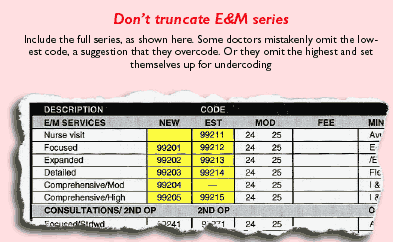
Your charge ticket should display as many of those CPT codes as reasonably possible. What's a realistic number? The typical 8.5 x 11-inch ticket can easily accommodate 60 to 70 CPT codes and still leave space for diagnosis codes, without resorting to squint-producing type. You can make room for dozens more by listing diagnosis codes on the back side of the form (more on that later). Or, use a one-sided, 8.5 x 14-inch ticket.
Experts recommend that you arrange procedure codes in an order that reflects the way you work. "Many doctors like the E&M codes first, followed by labs and radiology, and then in-office procedures," says consultant Crystal Reeves.
Include a column for fees along with the columns for codes and procedure descriptions. True, you don't need to write the fee on the ticket to generate an insurance claim, since fees are already loaded in your practice management system, but, it's still a valuable data field to include. If a patient wants to know how much he's being charged for what service, a cashier can fill in the blanks and hand him a copy.
The ticket should also include Medicare equivalents to CPT codes, notes Mary Ann Mueller, president of Trellis Billing Services in Hoffman Estates, IL. "The CPT code for venipuncture is 36415, but Medicare uses G0001," says Mueller. "If you don't print both, you might accidentally bill Medicare with 36415, triggering a denial."
Mueller also advises including CPT modifiers where they'll be used. "Modifiers 24 and 25 belong with the E&M codes, for example," she says.
You also need a means of linking diagnosis codes to CPT codes when you have two or more in each category. "You may not be paid without the linkage, but staffers who enter charges off the ticket may not know which diagnosis justifies which procedure," says Jennifer Bever, a consultant with KarenZupko & Associates in Chicago. "One solution is numbering the diagnoses and then writing the number next to the corresponding CPT code."
Avoid these pitfalls with E&M codes
Mess up the E&M section of a charge ticket and you might as well print "Audit Me" on the top. To stay out of trouble, make sure each series of E&M codes is complete. "Doctors have been known to leave off 99211 or even 99212 for office visits with established patients," says Crystal Reeves. "That makes them look like habitual overcoders."
"The opposite is true, toodoctors will omit 99215, even though some visits warrant it. That's undercoding."
Also list E&M codes for preventive care. "A primary care doctor will say, 'Why put them on? Medicare doesn't pay for them,' " says Reeves. "But some doctors will code the preventive visit as an office visita 99213, for instancewhich is illegal."
Likewise, be sure you list E&M codes for new-patient office visits, even if you're a specialist and referrals account for most of your practice. You may be inclined to list only consultation codes, which tend to pay more. But you'll see new patients on occasion, and if you code those visits as consultations, you'll invite legal problems.

Jennifer Bever has come across the reverse situation. "A charge ticket for a surgical practice didn't list consultation codes," says Bever. "Everything was a regular office visit for new or established patients. The surgeons were losing thousands of dollars that way."
Diagnosis codes: Make them detailed
Like CPT codes, the diagnosis codes on your ticket should mirror your particular practice. Again, query your practice management system for a list of ICD-9-CM codes for your 100 most common diagnoses.
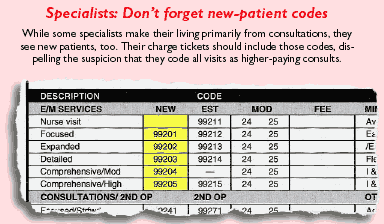
How you organize them is a matter of preference. Some physicians group diagnosis codes according to physiologic system and disease type. Others simply put them in alphabetical order. One advantage of going from A to Z is that it's easier for billers who haven't mastered medical taxonomy to look up codes. Since some diagnoses must be coded to the fourth and fifth digit to justify reimbursement, don't print only a generic code, such as 789.00 for unspecified abdominal pain. Instead, leave blanks after the first three digits to capture details like pain location.
The same applies to codes for widespread and complex chronic illnesses such as diabetes. Many tickets, for example, just list 250.00 for uncomplicated diabetes mellitus, noninsulin dependent, and 250.01 for its insulin-dependent counterpart. That's fine, but both codes apply only to patients who have their diabetes under control. What about those with uncontrolled diabetes, who might need longer visits with a higher E&M code?
Accordingly, billing expert Mary Ann Mueller suggests leaving the fifth digit blank for uncomplicated diabetes mellitus and listing all four choices for the final digit, which will reflect both the type of diabetes and the state of control. You may also want to include codes for diabetes-mellitus patients who have various complications that dictate the fourth digit, says Mueller.
That desire for detail, though, runs up against space limitations; 70-90 diagnosis codes can fit on an 8.5 x 11-inch ticket; 150 codes or so fit on an 8.5 x 14-inch form. To boost the number they can fit, some doctors put their ICD-9-CM codes on the reverse side. However, there's always the risk that a doctor won't bother turning over the sheet, and instead will rely on his memory, says consultant Sharon Rentze with RBG&Co. in St. Louis. "He's better off working with fewer codes on the front," says Rentze. "At least he'll see them."
Specialists aren't under the gun to include as many diagnosis codes as primary care doctors are since they see patients with a narrower range of problems, notes Mary Ann Mueller. "Plus, if they're like cardiologists and do a ton of procedures, they're better off maximizing the space on the charge ticket for CPT codes."
Of course, you can also think outside the charge ticket and print diagnosis codes on a laminated cheat sheet that fits in your coat pocket. Or, load the entire list of IDC-9-CM codes on a PDA.
Be a stickler for accuracy
CPT and ICD-9-CM manuals are in constant flux. Every year, new codes are born and old codes die or get tweaked. So update your charge ticket and your practice management system once a year. Otherwise, insurers will deny your claims based on erroneous codes.
Diagnosis code revisions that took effect last October, for example, replaced an all-purpose code of 600.0 for benign hypertrophy of prostate with two codes600.00 for BPH without urinary obstruction, and 600.01 for BPH with urinary obstruction. And the 2004 CPT manual eliminated "starred" procedures (the procedure codes incorporated an asterisk) for minor surgical services in conjunction with a new-patient visit. The move was intended to encourage physicians to instead attach modifier 25 to an E&M code to receive extra reimbursement for the surgical work.
There are other ways for errors to creep onto your charge ticket, too. A number may be transposed, so the CPT code 11100 for a single skin biopsy becomes 11010 for a kind of wound debridement. Or the person creating the ticket may simply choose the wrong code. "One internal medicine practice wanted a general diagnosis code for wounds that would justify sutures, debridement, and the like," says Crystal Reeves. "They mistakenly used 998.2 for accidental punctures or lacerations during a procedure, which made it appear that they were always correcting mistakes."
Doctors also get into trouble when the description on the charge ticket strays from the official description that comes with the CPT code. It's one thing to substitute an accurate summary, but it's another to distort the meaning, which may lead to errant coding. The description for 99396, for instance, is "established patient, periodic comprehensive preventive medicine" for patients 40 to 64 years old. Reeves recalls how one FP described it as "well-woman exam" on his ticket. "Does that mean he never billed a 99396 for a man?" asks Reeves.
To run a tight ship, include these details
Your practice management system stores a wealth of financial and clinical data. Some of it belongs on your ticket in the patient demographic section.
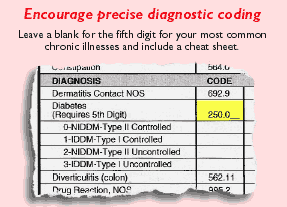
Mary Ann Mueller recommends printing out the patient's last diagnosis. "This is valuable for a doctor who performs a service like setting and casting a fracture and then sees the patient on a follow-up visit during the 90-day global period," says Mueller. "The diagnosis reminds everybody the visit can't be billed."
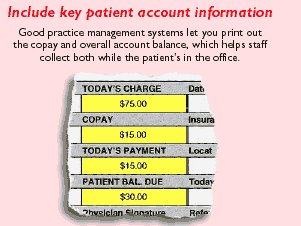
You can also turn your charge ticket into a collection tool simply by printing the patient's copay and any past due balance. "This information cues the cashier to collect the money at the time of service," says consultant Bever. "Most major practice management software programs can add this to the ticket, but I frequently find it missing."
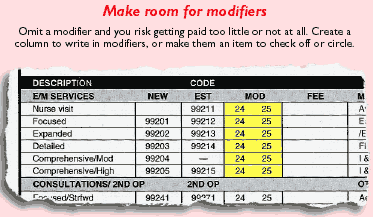
For the sake of good recordkeeping, each ticket must have a tracking number, adds Bever. "You need it for an end-of-day reconciliation," she says. "Most software programs let you generate a missing-ticket report, so that if you printed 30 tickets and entered charges for 28, you can track down the missing ones. Maybe the patient cancelled, but you never recorded that in the system. Or the ticket's on the doctor's desk. Or a staffer destroyed it in an effort to embezzle a copay.

"Most programs can print a tracking number, but staffers have been known to turn off this function because they consider the reconciliation process too cumbersome."
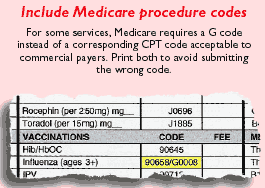
Tips on graphic design and printing
While you want a detailed charge ticket, you don't want one so packed with codes and patient data that it's hard to read. Resist the temptation to make the type size smaller than 8 point, unless you intend to use a magnifying glass.
Likewise, don't run all your E&M codes together. Instead, use gray-tone headers for each series. And leave some blanks in the procedural and diagnostic sections for when you need to write in infrequent codes by hand.
The strategic use of boldface can remind you to use codes you tend to overlook, such as 90471 for vaccine administration. "Doctors will code for the vaccine itself, but often forget to code for actually injecting it," says Mary Ann Mueller.
Years ago, physicians routinely hired local printers to produce their charge tickets. Increasingly they print their own tickets using a form generated by their practice management software program. There's an argument for each approach.
On one hand, using a professional printer may give you a more polished, readable ticket that makes the most of limited space. Printers also can produce tickets with duplicate copies, which may be hard to do yourself, adds Jim Novak, an executive in the forms division of Misys Healthcare Systems, which sells practice management software.
Printing tickets yourself, though, is generally cheaper than using a professional printing service, especially if you dispense with multicopy forms. "You can get by with one copy," says consultant Sharon Rentze. "If a patient wants a receipt, give him one from an inexpensive receipt book."
Another downside to commercial printing: Doctors in group practice often decide to print one generic ticket in order to get volume price breaks, instead of separate tickets tailored to each doctor's needs. Creating them in-house lets you easily produce customized tickets, even special ones for hospital or nursing home care.
Whichever way you crank out your ticket, ask a consultant, a local coding expert, or someone else with a fresh pair of eyes to review the prototype for accuracy and usefulness. After all, a lot rides on that piece of papernothing less than the well-being of your practice.
Robert Lowes. Practice Pointers: This piece of paper can boost your income. Medical Economics Aug. 6, 2004;81:18.





